The story of Damilola Olufemi Taylor is a poignant narrative that resonates deeply with the themes of youth, innocence lost, and the systemic failings of society's protective mechanisms.
Born on December 7, 1989, in Lagos, Nigeria, to Richard and Gloria Taylor, Damilola was a beacon of hope and dreams for his family. His life in Nigeria, where he attended Wisdom Montessori School in Ikosi, Ketu, Lagos, was a prelude to a journey that his family hoped would lead to better opportunities and the promise of a brighter future. In August 2000, Damilola and his family traveled to the United Kingdom, seeking treatment for his sister's epilepsy, a move that unknowingly set the stage for a tragedy that would later unfold.
On November 27, 2000, a mere three months after his arrival in the UK, Damilola's life was tragically cut short in an event that would leave a permanent scar on the collective memory of the nation. At just ten years old, Damilola set off from Peckham Library in southeast London, embarking on what should have been a short walk home. Captured on CCTV as he walked away, he approached the North Peckham Estate, where he was attacked, resulting in a fatal gash to his left thigh that severed an artery. Despite managing to stagger to a stairwell, he collapsed and bled to near death in approximately 30 minutes. Damilola was still alive when he was placed in an ambulance on his way to the hospital, but succumbed to his injuries 10 days shy of his 11th birthday.
The subsequent investigation into Damilola's death would reveal a series of forensic blunders that significantly impeded the pursuit of justice. Initial failures to detect Damilola's bloodstains on the clothing of suspects Danny and Ricky Preddie, who were among the first arrested following the incident, led to a botched trial and the eventual release of the suspects due to the lack of forensic evidence. It was only after a new investigating officer decided to re-examine all available evidence that the crucial bloodstains were discovered, paving the way for the conviction of the Preddie brothers for manslaughter in a retrial.
This case, marked by its forensic mishaps and the resulting government-ordered probe into the Forensic Science Service, highlights the critical importance of diligent and accurate investigative processes. Deputy Assistant Commissioner John Yates's admission that "clearly things were missed in the first investigation" underscores a systemic issue that had broader implications for other cases across the country.
The trials and retrials that followed Damilola's death were a testament to the complexity of achieving justice in the face of evidential and procedural errors. Despite the eventual conviction of the Preddie brothers for manslaughter, the path to this outcome was fraught with challenges, including initial acquittals, the introduction of new DNA techniques, and the reliance on the testimony of expert witnesses. The convictions brought a measure of closure, yet they also served as a reminder of the fragility of life and the profound impact of violence on communities.
The legacy of Damilola Taylor extends far beyond the details of his death and the trials that sought to bring his killers to justice. In the wake of this tragedy, Damilola's parents, Richard and Gloria Taylor, founded the Damilola Taylor Trust to combat knife crime and work towards the betterment of disadvantaged children. Their dedication to these causes, even in the face of their own profound loss, is a powerful testament to the resilience of the human spirit and the capacity for hope and transformation in the aftermath of tragedy.
Richard Taylor's subsequent appointment as an anti-knife crime and youth violence envoy and his receipt of an OBE for services to youth charities further illustrate the impact that individuals can have in fostering positive change within their communities. The establishment of the Day of Hope on December 7, 2020, to mark two decades since Damilola's death, serves as a reminder of the enduring power of hope and the potential for healing and unity in the face of adversity.
Damilola Taylor's story, though marred by tragedy, continues to inspire and motivate efforts towards creating a safer and more just society. His legacy lives on in the work of the Damilola Taylor Trust, in the campaigns against knife crime, and in the hearts of all those who continue to seek justice and peace in their communities. As we reflect on Damilola's life and the circumstances of his untimely death, let us also remember the potential for positive change that can arise from the depths of despair, and the importance of working together to protect the most vulnerable among us.
Written by: Alan Owen
The story of Damilola Olufemi Taylor is a poignant narrative that resonates deeply with the themes of youth, innocence lost, and the systemic failings of society's protective mechanisms.
Born on December 7, 1989, in Lagos, Nigeria, to Richard and Gloria Taylor, Damilola was a beacon of hope and dreams for his family. His life in Nigeria, where he attended Wisdom Montessori School in Ikosi, Ketu, Lagos, was a prelude to a journey that his family hoped would lead to better opportunities and the promise of a brighter future. In August 2000, Damilola and his family traveled to the United Kingdom, seeking treatment for his sister's epilepsy, a move that unknowingly set the stage for a tragedy that would later unfold.
On November 27, 2000, a mere three months after his arrival in the UK, Damilola's life was tragically cut short in an event that would leave a permanent scar on the collective memory of the nation. At just ten years old, Damilola set off from Peckham Library in southeast London, embarking on what should have been a short walk home. Captured on CCTV as he walked away, he approached the North Peckham Estate, where he was attacked, resulting in a fatal gash to his left thigh that severed an artery. Despite managing to stagger to a stairwell, he collapsed and bled to near death in approximately 30 minutes. Damilola was still alive when he was placed in an ambulance on his way to the hospital, but succumbed to his injuries 10 days shy of his 11th birthday.
The subsequent investigation into Damilola's death would reveal a series of forensic blunders that significantly impeded the pursuit of justice. Initial failures to detect Damilola's bloodstains on the clothing of suspects Danny and Ricky Preddie, who were among the first arrested following the incident, led to a botched trial and the eventual release of the suspects due to the lack of forensic evidence. It was only after a new investigating officer decided to re-examine all available evidence that the crucial bloodstains were discovered, paving the way for the conviction of the Preddie brothers for manslaughter in a retrial.
This case, marked by its forensic mishaps and the resulting government-ordered probe into the Forensic Science Service, highlights the critical importance of diligent and accurate investigative processes. Deputy Assistant Commissioner John Yates's admission that "clearly things were missed in the first investigation" underscores a systemic issue that had broader implications for other cases across the country.
The trials and retrials that followed Damilola's death were a testament to the complexity of achieving justice in the face of evidential and procedural errors. Despite the eventual conviction of the Preddie brothers for manslaughter, the path to this outcome was fraught with challenges, including initial acquittals, the introduction of new DNA techniques, and the reliance on the testimony of expert witnesses. The convictions brought a measure of closure, yet they also served as a reminder of the fragility of life and the profound impact of violence on communities.
The legacy of Damilola Taylor extends far beyond the details of his death and the trials that sought to bring his killers to justice. In the wake of this tragedy, Damilola's parents, Richard and Gloria Taylor, founded the Damilola Taylor Trust to combat knife crime and work towards the betterment of disadvantaged children. Their dedication to these causes, even in the face of their own profound loss, is a powerful testament to the resilience of the human spirit and the capacity for hope and transformation in the aftermath of tragedy.
Richard Taylor's subsequent appointment as an anti-knife crime and youth violence envoy and his receipt of an OBE for services to youth charities further illustrate the impact that individuals can have in fostering positive change within their communities. The establishment of the Day of Hope on December 7, 2020, to mark two decades since Damilola's death, serves as a reminder of the enduring power of hope and the potential for healing and unity in the face of adversity.
Damilola Taylor's story, though marred by tragedy, continues to inspire and motivate efforts towards creating a safer and more just society. His legacy lives on in the work of the Damilola Taylor Trust, in the campaigns against knife crime, and in the hearts of all those who continue to seek justice and peace in their communities. As we reflect on Damilola's life and the circumstances of his untimely death, let us also remember the potential for positive change that can arise from the depths of despair, and the importance of working together to protect the most vulnerable among us.
Written by: Alan Owen
Family Members
Sponsored by Ancestry
Advertisement
Explore more
Sponsored by Ancestry
Advertisement





